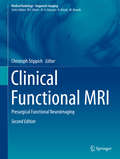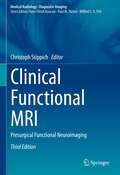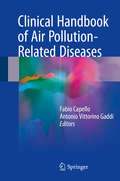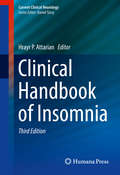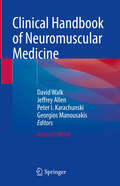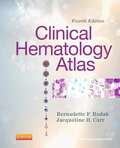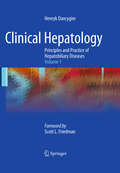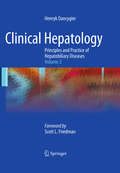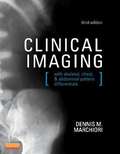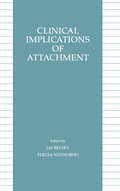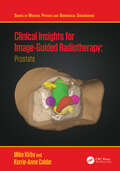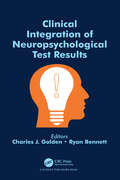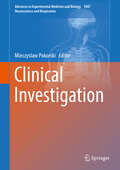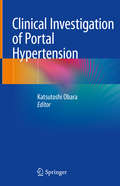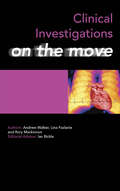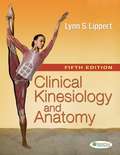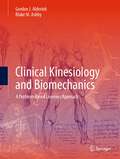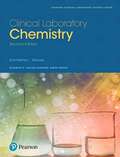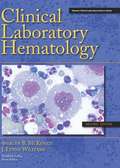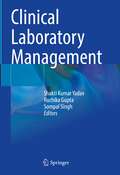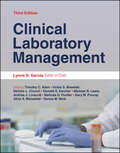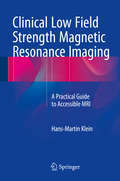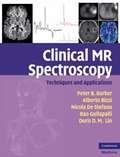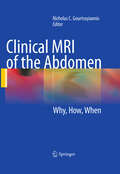- Table View
- List View
Clinical Functional MRI: Presurgical Functional Neuroimaging (Medical Radiology)
by Christoph StippichThe second, revised edition of this successful textbook provides an up-to-date description of the use of preoperative fMRI in patients with brain tumors and epilepsies. State of the art fMRI procedures are presented, with detailed consideration of practical aspects, imaging and data processing, normal and pathological findings, and diagnostic possibilities and limitations. Relevant information on brain physiology, functional neuroanatomy, imaging technique, and methodology is provided by recognized experts in these fields. Compared with the first edition, chapters have been updated to reflect the latest developments and in particular the current use of diffusion tensor imaging (DTI) and resting-state fMRI. Entirely new chapters are included on resting-state presurgical fMRI and the role of DTI and tractography in brain tumor surgery. Further chapters address multimodality functional neuroimaging, brain plasticity, and pitfalls, tips, and tricks.
Clinical Functional MRI: Presurgical Functional Neuroimaging (Medical Radiology)
by Christoph StippichThe third, revised edition of this successful book describes up-to-date preoperative fMRI and complementary advanced imaging methods (DTI, MEG, PET, etc.) to diagnose and treat patients with brain tumors and epilepsy. It presents the state of the art fMRI and complementary imaging procedures and discusses practical aspects, imaging and data processing steps, normal and pathological findings, and diagnostic possibilities and limitations. Experts in the field explain relevant information on brain physiology, functional neuroanatomy, and imaging techniques.All chapters of the second edition have been fully updated to reflect the latest developments. Multimodality functional neuroimaging was rewritten by new authors. Further chapters address brain plasticity, and pitfalls, tips, and tricks.
Clinical Handbook of Air Pollution-Related Diseases
by Fabio Capello Antonio Vittorino GaddiThis book examines in detail the clinical implications of those diseases that either are primarily triggered by air pollution or represent direct consequences of air pollutants. The aim is to provide medical practitioners with practical solutions to issues in diagnosis and treatment while simultaneously furnishing other interested parties with crucial information on the field. The book introduces the concept that air pollution-related diseases constitute a new class of pathologies. A wide range of conditions mainly attributable to air pollution are discussed, covering different body systems and pollution impacts in subsets of the population. In addition to presenting state of the art overviews of clinical aspects, the book carefully examines the implications of current knowledge for social and public health strategies aimed at disease prevention and prophylaxis. The Clinical Handbook of Air Pollution-Related Diseases will greatly assist doctors and healthcare workers when dealing with the consequences of air pollution in their everyday practice and will provide researchers, industry, and policymakers with valuable facts and insights.
Clinical Handbook of Insomnia (Current Clinical Neurology)
by Hrayr P. AttarianExpanding on the critical contributions of previous editions, this updated and comprehensive resource covers the latest diagnostic criteria of insomnia. The book is thematically divided into two parts. The first section consists of chapters on nomenclature, epidemiology, pathophysiology, diagnosis and differential diagnosis, complications and prognosis and treatment both pharmacological and behavioral. The second features chapters on insomnia in special populations, including ones on children and adolescents, cancer sufferers and survivors, in pregnancy, in menopausal women and in patients with neurological disorders and those with psychiatric illnesses. This third edition fills an important niche in the medical literature by addressing insomnia in its multiple forms, summarizes the findings published in different medical journals, and presents these to the practicing health care provider in an easily accessible format.
Clinical Handbook of Neuromuscular Medicine
by Jeffrey Allen David Walk Peter I. Karachunski Georgios ManousakisThis updated and expanded new edition provides a concise introduction to the Neuromuscular Medicine subspecialty of neurology for residents and fellows. It's organized by disease states and includes chapters on diagnostic and management tools of particular relevance, including muscle and nerve biopsy, EMG and nerve conduction studies, neuromuscular genetic testing, and rehabilitation interventions of particular relevance to this patient population. New to this edition are a section on neuromuscular ultrasound, a listing of validated outcome measures and functional scales in neuromuscular disease, interim advances in treatments, advances in understanding of mechanisms of disease, an expanded section on symptom and disability management, a single source listing outcome measures and functional scales, and a discussion on the growing importance of neuromuscular ultrasound and MR imaging. An indispensable guide for neurology residents and fellows, neuromuscular medicine fellows starting their training, practicing neurologists, and providers in related fields that have high exposure to neuromuscular disease populations.
Clinical Hematology Atlas (Fourth Edition)
by Bernadette F. Rodak Jacqueline H. CarrAn excellent companion to Rodak's Hematology: Clinical Principles & Applications, this atlas is ideal for helping you accurately identify cells at the microscope. It offers complete coverage of the basics of hematologic morphology, including examination of the peripheral blood smear, basic maturation of the blood cell lines, and discussions of a variety of clinical disorders. Over 400 photomicrographs, schematic diagrams, and electron micrographs visually clarify hematology from normal cell maturation to the development of various pathologies. Normal Newborn Peripheral Blood Morphology chapter covers the unique normal cells found in neonatal blood. A variety of high-quality schematic diagrams, photomicrographs, and electron micrographs visually reinforce your understanding of hematologic cellular morphology. Spiral binding and compact size make this book easy to use in a laboratory setting. Coverage of common cytochemical stains, along with a summary chart for interpretation, aids in classifying malignant and benign leukoproliferative disorders. Morphologic abnormalities are presented in chapters on erythrocytes and leukocytes, along with a schematic description of each cell, to provide correlations to various disease states. Body Fluids chapter covers the other fluids found in the body besides blood, using images from cytocentrifuged specimens. Updated information on the subtypes of chronic lymphocytic leukemia (CLL) helps you recognize variant forms of CLL you may encounter in the lab.
Clinical Hepatology: Principles and Practice of Hepatobiliary Diseases: Volume 1 (Mount Sinai Expert Guides)
by Henryk DancygierClinical Hepatology - Principles and Practice of Hepatobiliary Diseases provides clear and comprehensive coverage of the etiology, mechanisms of disease, diagnosis, and practical management of the entire spectrum of liver and biliary disorders. It also affords an excellent, evidence-based review of the rapidly expanding field of hepatobiliary diseases.
Clinical Hepatology: Principles and Practice of Hepatobiliary Diseases: Volume 2 (Mount Sinai Expert Guides)
by Henryk DancygierClinical Hepatology - Principles and Practice of Hepatobiliary Diseases provides clear and comprehensive coverage of the etiology, mechanisms of disease, diagnosis, and practical management of the entire spectrum of liver and biliary disorders. It also affords an excellent, evidence-based review of the rapidly expanding field of hepatobiliary diseases.
Clinical Imaging with Skeletal, Chest, and Abdomen Pattern Differentials
by Dennis MarchioriClinical Imaging by Dennis Marchiori is a comprehensive text with a clear, concise writing style that allows students and practitioners to quickly develop a better understanding of diagnostic imaging. Covering soft tissue imaging and skeletal imaging, including brain and spinal cord, chest, and abdomen, Clinical Imaging seamlessly integrates plain film with MRI and CT.
Clinical Implications of Attachment (Child Psychology Series)
by Jay Belsky Teresa NezworskiFirst published in 1987. This study records findings of a study group set up to explore a variety of issues related to attachment, including the predictive utility of Strange Situation assessments, the conditions under which insecurity is related to subsequent difficulties, the origins of individual differences in attachment security, and intervention strategies that might prove useful in ameliorating the developmental risks that appeared to be associated with insecure attachment relationships
Clinical Insights for Image-Guided Radiotherapy: Prostate (ISSN)
by Mike Kirby Kerrie-Anne CalderThis book provides a clinical insight into image-guided radiation therapy (IGRT) for prostate cancer. It starts by setting the clinical scene, discussing immobilisation and standard IGRT practice and then considering important developments like IGRT with non-ionising radiation, adaptive radiotherapy, particle therapy, margins, hypofractionation, clinical outcomes, AI and training. Good IGRT requires both technical and clinical focus. So, in complement to our first study guide on IGRT, this book now brings together key, clinical insights into IGRT for Prostate Cancer patients, with a view to helping the professional learn more about ‘how-to’ undertake IGRT for these patients more accurately, effectively and safely, throughout the whole course of a patient’s treatment with radiation.This clinical insight guide will be of interest to newly qualified radiation therapists, therapeutic radiographers, medical dosimetrists, medical physicists, radiotherapy physicists and clinical oncologists. It will also be of use for trainees and can be used alongside continuing competency and clinical training within real clinical departments and radiation therapy centres worldwide.This is the first in a forthcoming series of clinical insights, each tackling a different treatment area. Further areas in the series will be: Head and Neck; Thorax; Breast; Pelvis; and the Brain.Key Features:• Internationally applicable, clinically focused, up-to-date and evidence based.· Accompanied by suitable electronic multimedia resources.· Authored by experts with decades of experience of pioneering electronic portal imaging and IGRT in clinical practice, pedagogic research and substantial experience of teaching/supervising students, trainees and qualified therapists/medical physicists at bachelors, postgraduate and doctoral levels.Mike Kirby and Kerrie-Anne Calder are well-respected authors and radiotherapy professionals, who have worked in radiotherapy physics/radiotherapy clinical and academic practice for nearly 35 years and 25 years respectively.Mike Kirby is a Senior Lecturer in Radiotherapy Physics at the University of Liverpool, UK, and an Honorary Lecturer at the University of Manchester, UK. He holds graduate and postgraduate qualifications in medical physics and has in total over 200 books, papers, oral and poster presentations to his name in the field of radiotherapy. Dr. Kirby holds professional membership of the Institute of Physics and Engineering in Medicine, the American Association of Physicists in Medicine, the American Society for Radiation Oncology, the European Society for Radiotherapy and Oncology and the British Institute of Radiology, is a Fellow of the Higher Education Academy and the British Institute of Radiology in the UK.Kerrie-Anne Calder is a Lecturer at the University of Liverpool, UK, where she educates undergraduate and post graduate students in many aspects of radiotherapy with a special interest and role in imaging training. Kerrie-Anne has graduate and postgraduate qualifications in radiotherapy, education and academic practice, is a member of the Society and College of Radiographers, and is a Fellow of the Higher Education Academy in the UK. She was a clinical and professional lead in IGRT (on-treatment verification imaging) within the NHS in the UK for over ten years.
Clinical Integration of Neuropsychological Test Results
by Charles J. Golden Ryan BennettThe interpretation of neuropsychological tests is a complex process which requires recognition of the multiple skills required to complete even the simplest tests. The purpose of this volume is to explore the various interpretive strategies used with a wide variety of commonly used tests in order to see beyond the skills suggested by the test title. By integrating these possible interpretations across multiple tests, the neuropsychologist can pinpoint those deficits which lie at the core of a client’s pattern of test results. It is intended for both professionals and for students starting to learn the clinical practice of neuropsychology.
Clinical Investigation (Advances in Experimental Medicine and Biology #1047)
by Mieczyslaw PokorskiClinical investigation plays an essential role in the differential diagnosis, biomarker development, and therapy and cure of diseases. The book presents a bench-to-bed approach, with broad empirical coverage by experienced practitioners. The articles include topics like cytokine receptors in lung cancer, conduciveness of oxidative stress to carcinogenesis, safety and effectiveness of surgical correction of deformed chest, diagnostic and treatment regimens in inflammation-ridden obstructive lung conditions, alterations in growth hormone secretion leading to disorders of growth and metabolism, microbiota transplantation in pediatric patients, and the promising markers of renal epithelial injury. Yet another issue concerns the restructuring of chronic pain management by establishing the community-based specialized pain clinics. The book aims to disseminate and deliberate on the latest interdisciplinary medical knowledge to enhance clinical outcomes. Being a blend of clinical investigation and practice the book is addressed to physicians, scientists, and allied health care professionals.
Clinical Investigation of Portal Hypertension
by Katsutoshi ObaraThis book thoroughly covers various diseases induced by portal hypertension, and introduces novel information for the treatment of patients. Individual chapters address the pathophysiology, diagnosis and treatment options available for the complications induced by portal hypertension. The book fosters practical understanding and provides more evidence-based treatment options in order to improve physicians’ ability to select optimal treatment methods for their patients. Further, it offers readers the latest information concerning developments of the disease such as esophaogastric varices, ectopic varices, portal thrombosis, refractory ascites and hepatic encephalopathy. Clinical Science of Portal Hypertensions is an indispensible resource for both beginning and experienced gastroenterological physicians, endoscopists, liver physicians, radiologists, gastroenterological surgeons, liver surgeons, etc. who treat patients with portal hypertension on a clinical or research basis.
Clinical Investigations on the Move
by Andrew Walker Rory Mackinnon Lina FazlanieThe Medicine on the Move series provides fully flexible access to subjects across the curriculum in a unique combination of print and mobile formats ideal for the busy medical student and junior doctor. No matter what your learning style, whether you are studying a subject for the first time or revisiting it during exam preparation, Medicine on the
Clinical Kinesiology and Anatomy (Fifth Edition)
by Lynn S. LippertThis book provides fundamental understanding of Kinesiology and anatomy from a clinical perspective.The anatomical basis of common pathological conditions is briefly described in most chapters to give greater clinical relevance.
Clinical Kinesiology and Biomechanics: A Problem-Based Learning Approach
by Gordon J. Alderink Blake M. AshbyThis new textbook uses a problem-based learning (PBL) approach for teaching the fundamentals of kinesiology and biomechanics to undergraduate and graduate students in the biomedical, rehabilitative, and exercise science fields. Case vignettes and problems for each major region of the body are presented – cervical spine, thoracic spine and rib cage, lumbar spine and pelvis, shoulder girdle, elbow/forearm, wrist, hand, hip, knee, and ankle/foot. For the cases on the spine and upper extremity, biomechanics of posture are included; for cases involving the hip, knee, and ankle/foot, an extensive study of gait analysis is also incorporated. These case vignettes are not preceded by chapters that provide foundational information. Rather, relevant anatomical, biomechanical, and other information needed to solve/explain each case are embedded in the relevant chapters presenting the clinical cases.
Clinical Laboratory Chemistry
by Robert SunheimerClinical Laboratory Chemistry is a part of Pearson’s Clinical Laboratory Science series of textbooks, which is designed to balance theory and application in an engaging and useful way. Highly readable, the book concentrates on clinically significant analyses students are likely to encounter in the lab. The combination of detailed technical information and real-life case studies helps learners envision themselves as members of the health care team, providing the laboratory services specific to chemistry that assist in patient care. The book’s fundamental approach and special features allow students to analyze and synthesize information, and better understand the ever-evolving nature of clinical chemistry. The Second Edition has been streamlined and updated to include four new chapters covering safety, pediatrics, geriatrics, and nutrition; real-life mini cases; new figures and photographs; updated sources and citations; and a complete teaching and learning package.
Clinical Laboratory Hematology (Second Edition)
by Shirlyn B. MckenzieDesigned to meet the needs of both clinical laboratory technicians and clinical laboratory scientists, CLINICAL LABORATORY HEMATOLOGY has been updated into a brand new edition. This comprehensive--yet easy to read--guide to hematology and hemostasis features cutting-edge technologies, high-quality photographs and micrographs, case studies, and convenient dual-level (basic and advanced) presentation of information. Visual cross-referencing (symbols) throughout make finding information exceptionally easy. Key chapters are presented by a number of different authors and experts in the field and include information on: cellular homeostasis; the Stucture and Function of Hematopoietic Organs; Hemolytic anemia; Nonmalignant lymphocyte disorders and much more.
Clinical Laboratory Management
by Shakti Kumar Yadav Sompal Singh Ruchika GuptaMedical laboratories not only assist the physicians in diagnosis and management of a disease but also play a role in community health. Apart from the analytical aspects of various investigations, the larger areas of human resource management, inventory management and the like have been gaining importance as a part of laboratory management. There is a felt need for an understanding of the managerial aspects of a clinical laboratory, especially in an institutional setting. Although this knowledge can be acquired from books on general management subject, there is a paucity of books dedicated to clinical laboratory management. Hence is a need for a simple and concise text for management in the clinical laboratory practice. This first-of-its-kind book contains 50 chapters and is divided into ten sections. It is intended to provide an all-encompassing overview of management in a clinical laboratory and is written in a way that makes the content easy-to-comprehend, especiallyfor those who have not been trained in the core management concepts. The book begins with an introduction to Laboratory Management and makes the reader familiar with the general aspect of management. Each section that follows focuses on an important aspect of laboratory management, including but not limited to human resource management, accounting and finance, quality control, laboratory hazards and safety, and more. Clinical Laboratory Management shall be a valuable resource for clinical laboratorians, students of medical laboratory technology, laboratory managers, and hospital managers. It aims to help readers understand the managerial aspects of a clinical laboratory and serve as more efficient clinical laboratory managers.
Clinical Laboratory Management (ASM Books)
by Lynne Shore GarciaClinical Laboratory Management Apply the principles of management in a clinical setting with this vital guide Clinical Laboratory Management, Third Edition, edited by an esteemed team of professionals under the guidance of editor-in-chief Lynne S. Garcia, is a comprehensive and essential reference for managing the complexities of the modern clinical laboratory. This newly updated and reorganized edition addresses the fast-changing landscape of laboratory management, presenting both foundational insights and innovative strategies. Topics covered include: an introduction to the basics of clinical laboratory management, the regulatory landscape, and evolving practices in the modern healthcare environment the essence of managerial leadership, with insights into employee needs and motivation, effective communication, and personnel management, including the lack of qualified position applicants, burnout, and more financial management, budgeting, and strategic planning, including outreach up-to-date resources for laboratory coding, reimbursement, and compliance, reflecting current requirements, standards, and challenges benchmarking methods to define and measure success the importance of test utilization and clinical relevance future trends in pathology and laboratory science, including developments in test systems, human resources and workforce development, and future directions in laboratory instrumentation and information technology an entirely new section devoted to pandemic planning, collaboration, and response, lessons learned from COVID-19, and a look towards the future of laboratory preparedness This indispensable edition of Clinical Laboratory Management not only meets the needs of today’s clinical laboratories but anticipates the future, making it a must-have resource for laboratory professionals, managers, and students. Get your copy today, and equip yourself with the tools, strategies, and insights to excel in the complex and ever-changing world of the clinical laboratory.
Clinical Low Field Strength Magnetic Resonance Imaging: A Practical Guide to Accessible MRI
by Hans-Martin KleinThis book covers all aspects of low field MRI, describing its advantages, problems and prerequisites. Individual chapters are devoted to site planning, safety considerations, coils, imaging technique, image quality optimization, the imaging of different anatomic regions and likely future developments. The factors that must be borne in mind when selecting a low field system are clearly identified and detailed attention is paid to the applications for which such a system is adequate. The focus on high field systems has led to a situation where only a few systems with field strengths lower than 0. 5 T survive. Some of these systems possess high field features such as multichannel coils and strong gradients; furthermore, sequence technology and image processing techniques taken from higher field strength systems have resulted in impressive imaging capabilities. While 1. 5-T systems will probably continue to remain the standard, low field systems offer advantages such as the feasibility of dynamic joint examinations, improvement of T1 contrast, reduction of "missile effects" and decreased radiofrequency exposure. Low field strength MRI consequently has the potential to contribute to optimal patient management and given comparable image quality, its application may become an issue of patient safety. This book will be an invaluable asset to all who are involved in planning and/or running a low field strength MRI facility.
Clinical MR Neuroimaging
by Peter B. Barker Jonathan H. Gillard Adam D. Waldman Jonathan H. Gillard Adam D. WaldmanThe physiological magnetic resonance techniques of diffusion imaging, perfusion imaging and spectroscopy offer insights into brain structure, function and metabolism. Until recently, they were mainly applied within the realm of medical research, but with their increasing availability on clinical MRI machines, they are now coming into clinical practice for the evaluation of neuropathology in individual patients. This book provides the reader with a thorough review of the underlying physical principles of each of these methods, as well as comprehensive coverage of their clinical applications. Topics covered include single- and multiple-voxel MRS techniques, MR perfusion based on both arterial spin labelling and dynamic bolus tracking approaches, and diffusion-weighted imaging, including techniques for mapping brain white matter fiber bundles. Clinical applications are reviewed in depth for each technique, with case reports included throughout the book. Attention is also drawn to possible artifacts and pitfalls associated with these techniques.
Clinical MR Spectroscopy
by Peter B. Barker Alberto Bizzi Nicola De Stefano Rao P. Gullapalli Doris D. M. LinIn vivo magnetic resonance spectrosopy (MRS) is increasingly being used in clinical practice, particularly for neurological disorders.
Clinical MRI of the Abdomen: Why,How,When
by Nicholas C. GourtsoyiannisThis volume, which explains why, when, and how abdominal MRI should be used, focuses in particular on the most recent developments in the field. After introductory chapters on technical considerations, protocol optimization, and contrast agents, MRI of the various solid and hollow viscera of the abdomen is addressed in a series of detailed chapters. Relevant clinical information is provided, and state of the art protocols presented. With the help of numerous high-quality illustrations, normal, variant, and abnormal imaging findings are described and potential artefacts highlighted. Differential diagnosis is given extensive consideration, and comparisons are made with competing methodologies when relevant. Each of the chapters is rounded off by a section on "pearls and pitfalls". The closing chapters focus on findings in the pediatric abdomen, advances in MRI specifically relevant to cancer patients, and the use of abdominal MRI at 3 Tesla. This book, written by leading experts, will be of value to all who are involved in learning, performing, interpreting, and reporting abdominal MRI examinations.
